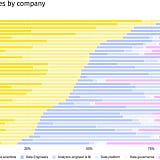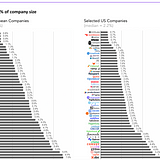Building Your Marketing Data Band: A Step-by-Step Guide
How to Build a Data-Driven Marketing Team: Strategies, Success Stories, and Practical Tips

Companies have been asking for better decisions, deeper customer insights and success. As marketers leaned into data for insights it became clear they needed more than gut feelings and catchy slogans. They needed tools, techniques and talent to understand the numbers.
This article will walk you through building a marketing data team — from hiring the right talent to leveraging the latest tools. Like forming a great band, it’s about assembling the right skills and creating a rhythm that matches your business goals. Let’s get started!
“The best teams are those that combine domain expertise with technical proficiency. In marketing analytics, this means bridging the gap between creativity and science.” — Data Science for Marketing Analytics by Tommy Blanchard and Debasish Behera
1. Finding Your Star Musicians: Hiring With Purpose
Think of your marketing data team as an ensemble where every role is crucial. It’s not just about data scientists or data analysts being rockstars; a successful team thrives on diverse talent. From data scientists driving innovation to marketing analysts connecting insights with strategies and data engineers ensuring data flows smoothly, each member contributes to the team’s effectiveness.
Your data scientists are like lead guitarists crafting solo pieces that grab attention while analysts and engineers create the foundation that keeps the performance grounded. This mix means your “band” can create well-integrated, high-impact strategies that rippled across the organization. Embracing variety is the key to forming a team where everyone feels valued and can contribute their unique skill set.
Key Hiring Tip: Define Clear Roles and Skills
For example:
- Data Scientist: Focus on modeling, predictive analytics and experimentation.
- Data Analyst / Marketing Analyst: Translate business questions into analytical tasks and deliver actionable insights.
- Data Engineer: Build and maintain data pipelines, ensure data quality and scalability.
- Project Manager or “Analytics Translator”: Keep projects on track, align stakeholders and promote collaboration.
Once you’ve got your talent assembled it’s time to define your sound — or in this case your goals.
“The data speaks, but it needs a purpose. In marketing, the purpose often revolves around predicting behavior and driving decisions.” — Mike Grigsby, Marketing Analytics: A Practical Guide to Real Marketing Science
2. Defining Your Genre: Setting Goals
Jazz bands improvise; rock bands bring power and intensity. Your team’s focus determines its tools and strategies. Are you looking at real-time customer behavior analysis or perhaps campaign optimization using predictive modeling? Each goal requires a different mix of methods, data pipelines and technologies.
Use Metrics & KPIs to Sharpen Your Focus
Tie your objectives to specific marketing KPIs so everyone is working in harmony. For example:
- Customer Acquisition Cost (CAC): ¿How much do you spend to bring in one new customer?
- Customer Lifetime Value (LTV): ¿What’s the predicted net profit from a customer relationship?
- Conversion Rate (CR): ¿How many users take a desired action (purchase, sign-up, etc.)?
- Return on Ad Spend (ROAS): ¿What’s the revenue generated for every dollar spent on advertising?
Real-World Example: Netflix
Netflix is a great example of using customer data for hyper-personalized video experiences. Their approach driven by predictive analytics and AI — tailors content recommendations and informs global marketing campaigns. This strategy has given Netflix over 280 million subscribers as of 2024, that’s the power of data-driven marketing. (Learn more via Netflix Marketing Strategy (2025) by Business Model Analyst)

Just like a classical orchestra needs violins while a blues band leans on harmonica, define your genre and get your team the right instruments.
3. Choosing Your Instruments: Tools & Technologies
Once your goals are clear, align them with the right tools:
- Data Processing & Analysis:
- Python or R for statistical modeling and advanced analytics.
-SQL for data extraction in relational databases. - Visualization & Reporting:
-Tableau, Power BI or Looker for dashboards and interactive insights.
-Google Data Studio or Metabase for lightweight, cost-effective visualization. - Marketing Automation & Attribution:
-HubSpot, Marketo or Salesforce Marketing Cloud to automate campaigns and track engagement.
-Attribution tools like Robyn or AppsFlyer for multi-touch attribution analysis.
Choose technologies that match your team’s skill level and the complexity of your marketing needs. The right stack helps you go from raw data to actionable insights seamlessly.
4. Jamming Together
No band skips rehearsal. That’s where musicians perfect their timing. Your team needs the same: regular meetings, brainstorming sessions, and cross-functional projects foster trust and spark creativity. Think of these moments as jam sessions where everyone contributes to the final outcome.
Cross-Functional Collaboration
To really make music across the organization, engage other teams:
- Product Teams for feature usage data and roadmap insights.
- Finance for budgeting, revenue metrics, and ROI calculations.
- Sales for feedback on lead quality and pipeline data.
Involve different departments to prevent silos and develop strategies that really work across the company.
5. Play Your First Gig: Start Small
Even The Beatles started with local gigs before selling out stadiums. Your team should do the same. Start with small, manageable projects to build confidence and credibility.
These “opening acts” help establish a rhythm and refine your process while demonstrating value to stakeholders. Include a timeline for each project to set realistic expectations — for instance:
- Customer Feedback Analysis: 2–3 weeks to gather and interpret user responses.
- Email Campaign Optimization: 4–6 weeks for A/B testing, subject line tweaks, and CTR improvements.
Early wins lay the groundwork for bigger data projects and help your team find its unique style.
6. Find Your Sound: Show Value
Great bands have a style; your data team should, too. Develop a reputation for delivering insights that inform decisions — like customer retention or campaign ROI. Use metrics, case studies, and real examples to prove your impact.
Sample KPI Improvements:
- Churn rate reduced from 5% to 3% by identifying at-risk segments.
- Email open rates increased by 20% through predictive A/B testing.
Like a band hits the charts, your “hits” will build your team’s credibility across the organization.
Success Case: Sephora’s Data-Driven Personalization
“Sephora’s digital innovation strategy seamlessly merges its loyalty program data, augmented reality tools, and advanced analytics to personalize the customer journey — empowering users to discover, experiment, and connect with products tailored to their unique needs.”

Key Takeaway:
By strategically using customer data across online and in-store channels, Sephora “finds its unique sound” in a crowded beauty market. Their approach showcases how personalization and digital innovation work together to strengthen brand loyalty and increase lifetime value.
7. Expand the Band: Grow Talent
When your band is playing to sold-out crowds, it’s time to add new members. As you tackle bigger, more complex projects, think about hiring specialists or bringing in AI tools to expand your capabilities.
“The future of marketing belongs to those who can adapt quickly to the fast-paced evolution of tools and techniques.”
— Analytics Vidhya article on marketing trends
Strategic Growth
- Small Teams (3–5 people): Focus on data engineering, analytics and project management.
- Mid-Sized Teams (5–10 people): Add data scientists for predictive modeling and personalization.
- Larger Teams (10–15+ people): Bring in specialized roles like ML engineers, attribution experts or privacy officers.
Growth should be intentional — don’t overwhelm your team with too many tools or bring in skills that don’t align with your goals.
You can explore more about how are structure the data teams in different companies in this articles by Mikkel Dengsøe

And some data about how are the ratios of this

8. Evolving: New Ways of Thinking
No one wants to hear the same song twice. Great bands change over time, so should your team. Invest in upskilling and encourage experimentation with new methods, like AI-driven analytics for personalization or NLP for sentiment analysis.
Data Governance & Privacy
As you grow, compliance becomes critical. From GDPR to CCPA and beyond, ethical data usage and privacy protection are non-negotiable. Consider appointing a privacy lead or embedding data ethics into every project plan. Trust and accountability are the foundation of sustainable data-driven marketing.
9. Performing: Sharing Insights
Bands play shows to connect with fans. Your data team should do the same share insights regularly with stakeholders:
- Interactive Dashboards: Give teams visibility into real-time data so they can adjust quickly.
- Engaging Presentations: Combine storytelling with visuals to demonstrate the impact of data-driven decisions.
When your audience sees how data informs strategy, they will stay engaged and supportive.9. Taking Feedback in Stride: Adjusting Your Setlist
10. Taking Feedback: Tuning Your Setlist
Not every show gets a standing ovation. Constructive feedback helps you improve. Whether internal or stakeholder feedback, use it to adjust your approach. Great bands often tweak their setlists based on audience reaction; your team should adapt to feedback to stay in harmony and deliver better results.
Common Gotchas to Watch Out For
- Too Many Tools Without Direction: Always connect analytics to clear business questions.
- Misaligned Hiring: Bringing in skills that don’t align with your team’s goals can cause confusion and waste.
- Data Ethics: Proper governance is key to trust and long-term success.
11. Finale: Celebrating
Bands celebrate album drops and sold out tours. Your team should too. Recognize big wins, completed projects and individual efforts. Happy team members create better “music” and a stronger data practice.
Final Act: Bringing It All Together
Building a marketing data science team is more than just hiring — it’s about orchestrating. With the right mix of talent, a clear vision and a commitment to learning your team can turn data into insights. Like a well rehearsed band a data team in sync can create strategies that leave a lasting impact across the business.
Time to Jam
Creating a marketing data team is like putting a great band together: you need the right talent, clear goals and ongoing “practice” to produce real hits. Give your team different skills, a common purpose and a culture of continuous improvement. Strike the balance between creativity and analytics and you’ll be delivering chart toppers that really resonate with everyone in the business.
Your team will adapt and evolve like a band, fine tuning their sound as the pace of data-driven marketing changes. The spark is there when each individual’s talent comes together to create something greater than the sum of its parts. With data as your sheet music and insights as your amp your next big hit is just around the corner.
Remember: a data-driven marketing team isn’t just about hiring clever people; it’s about a group that balances the creative with the analytical. If you get that right you’ll hit all the right notes — and create “music” that resonates throughout the business.
References
- Blanchard, T., & Behera, D. (2019). Data Science for Marketing Analytics. Packt Publishing.
- Grigsby, M. (2015). Marketing Analytics: A Practical Guide to Real Marketing Science. Kogan Page.
Further Reading
To further enhance your understanding of data science in marketing and improve your team’s effectiveness, consider exploring the following resources:
- Data Science for Marketing Analytics by Tommy Blanchard and Debasish Behera: A comprehensive guide that delves into practical applications of data science in marketing.
- Marketing Analytics: A Practical Guide to Real Marketing Science by Mike Grigsby: This book offers insights into how analytics can drive better marketing decisions.
The contents of external submissions are not necessarily reflective of the opinions or work of Maven Analytics or any of its team members.
We believe in fostering lifelong learning and our intent is to provide a platform for the data community to share their work and seek feedback from the Maven Analytics data fam.
Submit your own writing here if you’d like to become a contributor.
Happy learning!
-Team Maven
